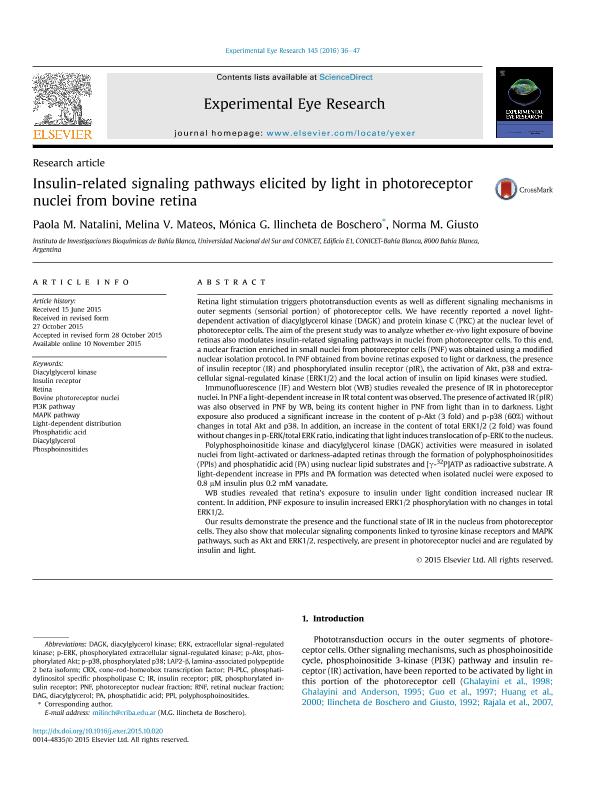Artículo
Insulin-related signaling pathways elicited by light in photoreceptor nuclei from bovine retina
Fecha de publicación:
11/2015
Editorial:
Elsevier
Revista:
Experimental Eye Research
ISSN:
0014-4835
Idioma:
Inglés
Tipo de recurso:
Artículo publicado
Clasificación temática:
Resumen
Retina light stimulation triggers phototransduction events as well as different signaling mechanisms in outer segments (sensorial portion) of photoreceptor cells. We have recently reported a novel lightdependent activation of diacylglycerol kinase (DAGK) and protein kinase C (PKC) at the nuclear level ofphotoreceptor cells. The aim of the present study was to analyze whether ex-vivo light exposure of bovine retinas also modulates insulin-related signaling pathways in nuclei from photoreceptor cells. To this end, a nuclear fraction enriched in small nuclei from photoreceptor cells (PNF) was obtained using a modified nuclear isolation protocol. In PNF obtained from bovine retinas exposed to light or darkness, the presence of insulin receptor (IR) and phosphorylated insulin receptor (pIR), the activation of Akt, p38 and extracellularsignal-regulated kinase (ERK1/2) and the local action of insulin on lipid kinases were studied. Immunofluorescence (IF) and Western blot (WB) studies revealed the presence of IR in photoreceptor nuclei. In PNF a light-dependent increase in IR total contentwas observed. The presence of activated IR (pIR)was also observed in PNF by WB, being its content higher in PNF from light than in to darkness. Light exposure also produced a significant increase in the content of p-Akt (3 fold) and p-p38 (60%) without changes in total Akt and p38. In addition, an increase in the content of total ERK1/2 (2 fold) was foundwithout changes in p-ERK/total ERK ratio, indicating that light induces Translocation of p-ERK to the nucleus.Polyphosphoinositide kinase and diacylglycerol kinase (DAGK) activities were measured in isolated nuclei from light-activated or darkness-adapted retinas through the formation of polyphosphoinositides (PPIs) and phosphatidic acid (PA) using nuclear lipid substrates and [gamma-32P]ATP as radioactive substrate. Alight-dependent increase in PPIs and PA formation was detected when isolated nuclei were exposed to 0.8 mM insulin plus 0.2 mM vanadate.WB studies revealed that retina´s exposure to insulin under light condition increased nuclear IR content. In addition, PNF exposure to insulin increased ERK1/2 phosphorylation with no changes in total ERK1/2.Our results demonstrate the presence and the functional state of IR in the nucleus from photoreceptor cells. They also show that molecular signaling components linked to tyrosine kinase receptors and MAPK pathways, such as Akt and ERK1/2, respectively, are present in photoreceptor nuclei and are regulated by insulin and light.
Archivos asociados
Licencia
Identificadores
Colecciones
Articulos(INIBIBB)
Articulos de INST.DE INVEST.BIOQUIMICAS BAHIA BLANCA (I)
Articulos de INST.DE INVEST.BIOQUIMICAS BAHIA BLANCA (I)
Citación
Natalini, Paola Marisel; Mateos, Melina Valeria; Ilincheta, Monica Graciela; Giusto, Norma Maria; Insulin-related signaling pathways elicited by light in photoreceptor nuclei from bovine retina; Elsevier; Experimental Eye Research; 145; 11-2015; 36-47
Compartir
Altmétricas




